October 17, 2008
Air Date: October 17, 2008
FULL SHOW
SEGMENTS
The Changing Climate of the EU's Climate Change Commitments
View the page for this story
A year after Europe took the lead in the international fight against global warming, some European Union member countries are having second thoughts about their commitments to reduce greenhouse gas emissions. Matt McGrath of the BBC World Service tells Living on Earth host Steve Curwood about the divisions in the EU, and what they'll mean for the next round of Kyoto Protocol negotiations. (05:30)
Obama’s Nuclear Balancing Act
/ Jeff YoungView the page for this story
Senator Obama told Iowa voters he's "not a proponent" of nuclear power." Then he pledged to "safely harness nuclear power." Just where does Barack Obama stand on nuclear power? Living on Earth’s Jeff Young finds out. (06:30)
The Palin Effect
/ Ingrid LobetView the page for this story
Governor Sarah Palin's number one political goal has been getting natural resources out of the earth and onto the market. Living on Earth’s Ingrid Lobet takes a look at the Alaskan governor’s environmental record and her potential energy priorities in a McCain-Palin presidency. (08:00)
Conservation and Diaspora
View the page for this story
The Pacific island nation Kiribati (Kir-uh-bahs) may soon become one of the first casualties of climate change. Rising sea levels due to warming temperatures are already having effects on the small island. But that hasn’t stopped the country from setting aside some of their pristine waters for conservation. Host Steve Curwood speaks with President Anote (ah-no-tay) Tong of the Republic of Kiribati and Dr. Greg Stone, vice president of Global Marine Programs at the New England Aquarium, about the Phoenix Islands Protected Area (10:00)
Last Bat Home
View the page for this story
Commentator Verlyn Klinkenborg watches the bats of dawn return to their roost and finds himself wanting to adjust to their schedule. (02:45)
A Village to Reinvent the World
View the page for this story
Four decades ago, a group of South Americans joined together to create an ecological utopia. The village, called Gaviotas, was based on the idea that they could use limited resources to create a sustainable community. In 1998, journalist Alan Weisman wrote a book about the Colombian experiment. It’s called “Gaviotas: A Village to Reinvent the World” and it’s just been updated for a 10th anniversary edition. Weisman talks with host Steve Curwood about his recent visit to Gaviotas and how the community is faring. (11:10)
Seedy Art
View the page for this story
At the Minnesota State Fair, seeds aren't just for planting – they’re used to create works of art. Living on Earth's Bobby Bascomb produced our audio postcard. (02:40)
Show Credits and Funders
Show Transcript
Host: Steve Curwood
Guests: Matt McGrath, Greg Stone, Anote Tong, Alan Weisman
Reporters: Bobby Bascomb, Ingrid Lobet, Jeff Young
Commentator: Verlyn Klinkenborg
[THEME]
CURWOOD: From Public Radio International, this is Living on Earth.
[THEME]
CURWOOD: I’m Steve Curwood. Faced with a global financial meltdown, the EU reconsiders its commitment to slash greenhouse gas emissions.
Also – we continue our probe of nuclear power and the presidential race.
ROWE: Senator McCain is clearly more committed and more out front on nuclear - Senator Obama is probably more out front on efficiency. We think you’ve gotta have both. And we’ve been in that position for a long time. I like both candidates - I’m very careful.
CURWOOD: And we return to Gaviotas - the ecovillage in Colombia that’s showing other nations a low-cost path to energy independence.
WEISMAN: Gaviotas windmills and pumps can be found from Chile to Mexico. There are many rural areas, in fact I can't think of many that I've traveled into that I didn't see a Gaviotas implement or two.
CURWOOD: That and more this week on Living on Earth. Stick around!
[MUSIC: Boards Of Canada “Zoetrope” from “In A Beautiful Place Out In The Country” (Warp Records 2000)]
ANNOUNCER: Support for Living on Earth comes from the National Science Foundation and Stonyfield Farm.
The Changing Climate of the EU's Climate Change Commitments

Could the financial crisis chill the EU’s warm feelings about fighting climate change?
[THEME]
CURWOOD: From the Jennifer and Ted Stanley studios in Somerville, Massachusetts, This is Living on Earth. I’m Steve Curwood.
In 2007 the European Union put its 27 member states on the front lines of the global warming battle by promising big cuts in greenhouse gas emissions. But a lot can happen in a year. Reductions have not been so easy for Italy, Spain and Eastern Europe, and with a global financial crisis to nurse, there are added fears that compliance will come at too high a price.
Joining me now from London is Matt McGrath. He's environmental correspondent with the BBC World Service who has been following the current round of the European climate negotiations. Thanks for joining me, Matt.
MCGRATH: Hi Steve, how are you?
CURWOOD: Now Matt, the European Union was supposed to lead the world in the fight against global warming, but now what – a year after pledging to decrease greenhouse gas emissions, the EU doesn’t seem so enthusiastic now about getting there. What’s going on?
MCGRATH: Yeah, there’s a chill wind blowing through the corridors of Europe at the moment and all that great unity of the 27 members seems to be going out the window a little bit. You remember just a year ago, they were talking about cuts of 20 percent of emissions by 2020, 20 percent improvement in energy efficiency by 2020 and 20 percent commitment to using renewables by 2020. All the twenties, as they call them. But now, after everything that’s happened with the economy and as the realization of how much this actually means in real terms is dawning on the leaders of the EU, there are some very, very cold feet, particularly in Eastern Europe, but not just there, in Germany as well and Italy – all over we’re seeing an outbreak of “well, we need to be a little bit more flexible about this.”
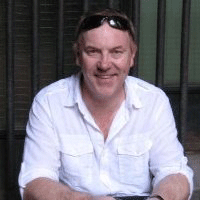
Matt McGrath, environmental correspondent for the BBC World Service.
MCGRATH: That is a good argument in some respects and there’s also another argument that in the current climate that we’re in, emission cuts will be more easily achieved because people will be using less oil, coal. But I think there’s just a general fear that the cost of the implementations, particularly in some countries, will make jobs disappear and at this particularly crucial time when we’re talking about spending billions of dollars around the world to save the banks, when people are fearing for their jobs as well, to be putting up the costs of making cars in Germany or whatever it might be and helping export those jobs to other parts of the world – that is a real political no-no, that’s something that no politician will want to do. So Angela Merkel, the German Chancellor, the most committed European in terms of driving these targets, is now starting to talk about backing off to protect the native industry that are very important to Germany, the big, heavy coal and steel industries, car manufacturing. Those are the jobs, and those jobs are held by people who vote, and they vote in German elections, and that’s the political reality meeting the “ideal,” if you like, in terms of the climate.
CURWOOD: Now tell me a bit about Poland in this situation. I understand that they’re leading this coalition to block the EU climate change package unless it’s modified. What are the Poles worried about and what do they want?
MCGRATH: The Poles have had a big problem because they generate 96 percent of their electricity from coal. They are a very coal dependent country. The alternative for them is to get gas from the Soviet – from Russia, which was part of the Soviet Union. They would have to become dependent back on Russia again, something that politically is a nonstarter in Poland.
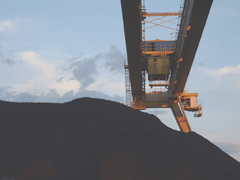
Zeran power plant in Warsaw. More than 90 percent of Poland’s electricity comes from coal. (Photo: Ludmila Krzewska)
CURWOOD: Ironically, Poland is the site of the next International Summit on Climate Change Negotiations in December. How might these tensions in the European community spill over into those negotiations?
MCGRATH: It’s a very interesting question because not only do you have the negotiations this December in Poznań, in Poland, but you’ve got the final round, the end of it all, the end of the [inaudible] show taking place in Copenhagen, also in Europe twelve months on. So in this time period where the European Union was hoping to present itself as the world leader, now you’ve got these first set of negotiations in the country with whom the European Union is at odds with how it actually conducts its policy. So it’s likely to take some of the wind from the sails of the European Union, and actually help it to backtrack a little bit. And I think there’s a feeling amongst other countries in the world that while the Europeans have been great at talking, when it comes to the negotiations they haven’t been as good as their word up to now.
CURWOOD: Both U.S. presidential candidates, major candidates, have come out in favor of mandatory limits on greenhouse gases. How possible is it that the United States takes the reins from Europe on climate change and leads the world towards the post Kyoto future?
MCGRATH: Well I suppose anyone who was in Bali last December and saw what happened to the U.S. delegation when the entire world turned on it and said “Look guys, we want to move ahead here and you guys are the roadblock” I think anybody who saw that would be surprised if there was a massive change, even with a McCain or an Obama administration. But I think there is a need, a desire, a belief that the United States could actually go from bad guy to world leader on this with a few judicious statements and a few judicious laws to go along with it. There will be a lot of positivity for a new president coming in – I suppose a honeymoon period, if you like – but when it gets down to closing the doors, will people give the new president the benefit of the doubt in terms of climate? It’s hard to know as yet, it’s very hard to know how that will pan out as yet.
CURWOOD: Matt McGrath is environmental correspondent for the BBC. Thanks Matt.
MCGRATH: My pleasure.
Related link:
Check out the BBC's science and environment news
Obama’s Nuclear Balancing Act
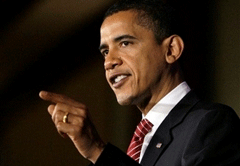
(Courtesy of Barack Obama)
CURWOOD: In the final presidential debate between Barack Obama and John McCain, the Republican nominee mentioned nuclear power six times, while the word “nuclear” never passed the lips of Senator Obama. So just where does the Democratic contender stand? Living on Earth's Washington correspondent Jeff Young reports.
YOUNG: Back in December, when Sen. Barack Obama was still the underdog in the
Democratic primary, he took a question on nuclear power at a campaign event in Iowa.
OBAMA: I start out with the premise that nuclear energy is not optimal. So I’m not a nuclear energy proponent.
YOUNG: Obama said he could not rule out nuclear power because it provides electricity without greenhouse gas emissions. But he pointed out the high costs, safety and waste problems.
OBAMA: Until we solve those problems and until the nuclear industry can show they can produce clean safe energy without enormous subsidies from the U.S. government, I don’t think that’s the best option.
YOUNG: That might leave the impression that Obama opposes nuclear power. But in a debate this month, Obama said that’s not so.
OBAMA: I favor nuclear power as one component of our overall energy mix.
YOUNG: So is Obama “not a proponent” of nuclear power or does he “favor nuclear power”? Well, both, explains Obama senior advisor on energy issues, Elgie Holstein.
HOLSTEIN: He absolutely supports the role that nuclear power plays in providing electricity to our economy. However, that does not turn his back on the very real problems, the high cost of nuclear power, the problems with permanently disposing of the waste. But these are solvable problems, and nuclear power can certainly continue to expand.
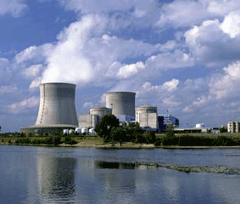
(Courtesy of the Department of Energy)
AURILIO: Senator Obama has said that he would keep nuclear on the table if you could address cost, safety and waste concerns. Our perspective is we oppose nuclear power unless you can solve the waste, safety and economic issues. So, Senator Obama is much closer to our position than Senator McCain is.
YOUNG: But over at the Nuclear Energy Institute, the industry’s lobbying group, they hear a different message from Obama. Here’s Alex Flint, the Institute’s senior vice president for government affairs.
FLINT: Senator Obama, looking at his objectives to meet climate change goals, recognizes nuclear is a necessary part of the answer. And then he sets a set of parameters that he wants to see. All those are things the industry is able to do. We think that means nuclear will be an important part of Senator Obama’s plans going forward.
YOUNG: Flint’s heartened to hear both major candidates support his industry. But there are some big differences. Senator McCain wants 45 new reactors by 2030. Obama avoids specific targets. And they differ sharply on how to deal with the waste. McCain wants to finish the Yucca Mountain site in Nevada for permanent storage of waste. And he wants to reprocess nuclear waste, as the French and Japanese do. Obama opposes reprocessing because that technology generates weapons-grade plutonium. And Obama opposes Yucca Mountain, as he told Nevada voters during a primary debate in January.
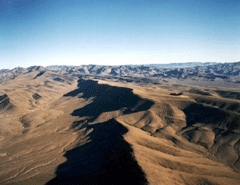
Yucca Mountain. (Photo courtesy of the Department of Energy)
YOUNG: But Flint, of the Nuclear Institute, thinks Obama’s position on Yucca has more to do with political science than sound science.
FLINT: I understand his concerns with Yucca Mountain. They principally are political, and I understand how a candidate for president, when going before Nevadans in advance of their caucuses would make commitments about Yucca Mountain. It’s an understandable phenomenon.
YOUNG: Obama campaign adviser Holstein says Flint is wrong about that.
HOLSTEIN: Senator Obama believes that the project has failed on the technical merits and also that it has failed to sustain the public trust and confidence, which is essential if you’re going to build a project of this scale.
YOUNG: Holstein says Obama favors dry casks for long-term storage until better waste disposal is found. That’s a system being used in Illinois, Obama’s home state. Illinois gets almost half its electricity from nuclear power – the highest rate in the country – and ten of the state’s 11 reactors are run by the Exelon corporation. John Rowe is Exelon’s CEO.
ROWE: Senator McCain is clearly more committed and more out front on nuclear. Senator Obama is probably more out front on efficiency. We think you’ve gotta have both. I like both candidates. I’m very careful.
YOUNG: He might like both, but Rowe is putting his money behind Obama. He and other Exelon employees gave $190,000 to the campaign. That’s despite an episode two years ago when Obama criticized Exelon for failing to notify the public about leaks of radioactive material. Obama wrote a bill to force disclosure of such leaks, but the bill failed in the face of industry lobbying. Greenpeace nuclear policy analyst Jim Riccio says it was probably an instructive experience.

(Courtesy of Barack Obama)
RICCIO: I think he probably learned a little political lesson when taking on the nuclear industry it’s a very powerful lobby. It has long arms.
YOUNG: A year earlier, Obama faced another big nuclear vote: the energy bill supported by President Bush included loan guarantees and other major incentives for the nuclear industry. That 2005 energy bill was the topic of one of the more memorable exchanges of this month’s presidential debates.
MCCAIN: And it was sponsored by Bush and Cheney. You know who voted for it? You might never know – that one. You know who voted against it? Me.
YOUNG: So the candidate who claims the strongest support for nuclear, McCain, criticizes his opponent for voting for a bill that supported nuclear power. It’s an odd twist. But as these candidates try to navigate new energy challenges and tricky political terrain, you can expect the unusual.
For Living on Earth, I’m Jeff Young in Washington.
[MUSIC: Broadway Project “I Partisan” from In Finite (ODS Records 2008)]
Related links:
- Barack Obama’s energy plan
- Environment America assesses the candidates’ nuclear plans
- Nevada’s agency for nuclear projects archives information on Yucca Mountain
- For more LOE election coverage, click here
The Palin Effect
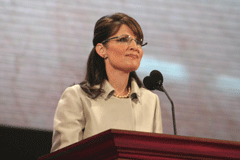
(Courtesy of the Republican National Convention)
CURWOOD: Vice Presidential nominee Sarah Palin boasts she took on the oil companies as Alaska’s governor – so what might she do in Washington? That’s just ahead here on Living on Earth.
[MUSIC: New York Electric Piano: “The Beauty Of Ambiguity” from King Mystery (Buffalo Puppy Record 2008)]
CURWOOD: It’s Living on Earth, I’m Steve Curwood.
Republican presidential nominee John McCain says if elected, his running mate, Alaska Governor Sarah Palin, would be his energy point person. For the past two years, Sarah Palin has governed a state with unparalleled natural resources.
Living on Earth's Ingrid Lobet looks at how the Alaska governor might influence energy and the environment in a McCain-Palin administration.
LOBET: It's a mining ticket – that's one way to view the McCain-Palin White House bid. Both candidates come from states where mining has a long history and sizeable sway. And with mineral prices high, companies are trying to win over Alaskans with promises of jobs in new mines.
PALIN: Mining is all we have. Without something happening out in our region to stimulate the economy, we're just going to wither away.
LOBET: Governor Palin's views on mining were tested this summer in a fight between that industry and another that's iconic in Alaska: fishing. A voter initiative would have sharply limited the waste allowed to flow from an immense proposed gold mine.
HALFORD: It would be an open pit mine that rivals any on earth. I believe that this issue will be the perfect storm of an environmental debate for the next ten or twenty years
LOBET: Republican Rick Halford is usually pro-mining. During decades in the Alaska state senate, he cast many votes for the industry. But he says sulfuric acid from the vast Pebble Mine could ruin the world's largest salmon fishery – Bristol Bay.
HALFORD: When you have a 500 billion dollar value in-place deposit estimate and you have 300 million dollars a year in fishery values, and you put them directly in conflict, it's going to be a perfect storm of a battle.
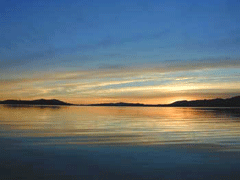
Bristol Bay, Alaska. Gov. Sarah Palin upset many in Alaska by opposing a proposition that would limit the amount of waste a proposed mine could dump into Bristol Bay. (Courtesy of the U.S. Geological Survey)
RASKIN: I believe she would do everything in her power to stop McCain from – if it did pass congress – signing the bill. I do believe it would be one of her strong issues to get the bill vetoed.
LOBET: Indeed Governor Palin has prioritized getting resources out of the ground, and she says she would continue that focus as vice president. She heads a multi-state agency that lobbies to advance American oil and gas interests. On the stump and in the vice presidential debate, she stresses it weakens the country to import so much petroleum.
PALIN: It's a nonsensical position we are in when we have domestic supplies of energy all over this great land, and East Coast politicians who don't allow energy-producing states like Alaska to produce these, to tap into 'em. Instead we're relying on foreign countries to produce for us.
LOBET: Governor Palin and Senator McCain agree on drilling for more oil and natural gas, both on and offshore. But they disagree on drilling in the Artic National Wildlife Refuge. Palin supports drilling in ANWR.
PALIN: What do you expect? A team of mavericks, of course we're not going to agree a hundred percent on everything. At least we can agree to disagree on that one, and I'm going to keep pushing him on ANWR, though.
LOBET: But some Alaskans, like Joe Geldhof of Repubicans for Environmental Protection say ANWR is a distraction. The real drilling activity is elsewhere.
GELDHOF: There's not much action on the Refuge. There’s a lot of rhetoric, but no real move to open it.
LOBET: The real hotspots for Alaska drilling are farther West: Prudhoe Bay and the Chukchi Sea. Palin became governor, in part, thanks to discontent over a deal to bring natural gas south via a pipeline from Prudhoe Bay. That deal, struck by ex-governor Frank Murkowski, was seen as too favorable to oil firms.
PERSILY: She pretty much said that is null and void and we're going to start over.
Larry Persily is a journalist who's also worked under three governors in Alaska, Democrat and Republican.
PERSILY: She was not going to negotiate with them, she was going to go the clear and transparent open bidding way to get a gasline and that’s what she did.
LOBET: Palin struck an agreement with pipeline company, TransCanada, to bring the natural gas to market. No pipe has been laid yet. Nor will it be anytime soon. But her actions did not endear her to BP, Conoco-Phillips and ExxonMobil up in America's largest oilfield.
PERSILY: Ohhh, they’re probably still sending her a Christmas card but it's probably signed by a machine, not by the CEO.
LOBET: Palin's other oil and gas goal, to drill in the Chukchi Sea, led her to sue the federal government when it decided to declare polar bears as threatened. She explained her opposition to the listing in a June interview with CNN's Glenn Beck.
PALIN: Our fear being that extreme environmentalists will use this tool, the ESA, to eventually just curtail or halt North Slope production of very rich sources that America needs. We need that oil, we need that gas. And I'm glad you're fired up about it, Glenn…
LOBET: Palin said her position reflected that of Alaska scientists. But documents later showed state biologists do consider the bears to be in peril.
Alaska has witnessed stronger climate changes than any other state. But Palin has not led on the issue. She's expressed doubt about human activity as a major cause of global warming. A climate cabinet she appointed reported how Alaskans can adapt to loss of sea ice and fisheries and eroding coastlines. And In joining the western states' Climate Initiative, Palin chose observer status. Again, environmental attorney Frances Raskin.
RASKIN: The key word there is "observer." I think Governor Palin probably is under a lot of pressure to do something about global warming, since it is a tremendous threat to Alaska. It’s threat to our fisheries, it’s a threat to infrastructure and to the native villages that are often right on the edge of the coast where they are suffering terrible erosion. But she has not signed on to any binding goals or come up with any ideas for reducing the addiction to oil.

(Courtesy of the Republican National Convention)
HALFORD: She's an excellent communicator and she's fairly courageous – and I think those are the ways he would use her.
LOBET: How Palin would fit in really depends on John McCain's governing style. Mark Trautwein observed John McCain up close for 20 years, beginning in 1982 when his boss, Congressman Mo Udall of Arizona, and McCain worked together on the House Interior Committee. He says the senator's approach to politics is extremely personal.
TRAUTWEIN: And this is obviously a new relationship he has with Governor Palin, so it is in the process of becoming. A vice president Palin's influence on a President McCain would depend on whether he truly likes and respects her, and that we just don't know.
LOBET: What we do know is that if the GOP ticket wins, we'll have a vice president shaped by a state where wilderness seems endless, and where more than 40 percent of revenue comes from petroleum.
For Living on Earth, I'm Ingrid Lobet.
Related link:
For more LOE election coverage, click here
Conservation and Diaspora
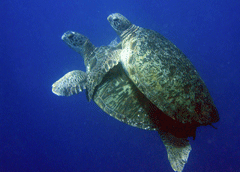
Two green sea turtles mating. The new Phoenix Islands Protected Area will provide an important habitat reserve green sea turtles, whose populations in the Pacific are in dramatic decline. (Courtesy of the New England Aquarium)
[MUSIC: Kiribati: All music is taken from the film Paradise Found: The Phoenix Islands produced by The New England Aquarium (2005)]
CURWOOD: The Phoenix Islands in the South Pacific occupy one of the most remote spots on Earth. It’s takes five days by boat to get there from the capital of Kiribati, to whom they belong, and for conservationists, that’s a good thing. These low-lying coral atolls are the centerpieces of what is now the world’s largest marine preserve, covering more than 73,000 square miles.

The Phoenix Islands. (Courtesy of phoenixislands.org)
CURWOOD: Certainly a paradise for Greg Stone. He’s a senior scientist and vice president of the New England Aquarium in Boston. Shortly after he first explored the Phoenix Islands back in the year 2000, he set about trying to protect the region. Part of his effort included helping to produce a film documenting these immense tracts of virgin coral reef.
Just as intact tropical rainforests house many terrestrial species, archipelagos of healthy tropical corals – organisms themselves – nurture prodigious amounts of marine life. And thanks to their remoteness and some favorable ocean currents, the Phoenix Islands have so far escaped the over fishing and warming oceans that have trashed many of the world’s coral reefs. During a recent visit to the Aquarium, Greg Stone took me by a tank filled with colorful fish – with a sign, “Phoenix Islands, Protecting Paradise”.
[SOUND OF AQUARIUM, KIDS LAUGHING]
STONE: The first thing you see is Nikumaroro, which is the first island I visited there. And then we see some beautiful pictures of the Napoleon Wrasse, which is one of the most valuable and endangered fish in the world and the Phoenix Islands has more of those than anywhere else in the world.
CURWOOD: I’m looking at a fish that looks like it’s kind of wearing brain coral on top of its head, and it almost has some sort of hairdo, like a really fixed bob cut or something.
STONE: And big lips.
CURWOOD: I don’t think that was done with augmentation, though.
STONE: No, I think this is the real thing. Actually, what happens is these fish are caught; and one fish can be worth five or ten thousand dollars.
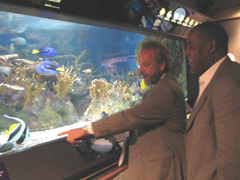
Dr. Stone shows host Living on Earth Steve Curwood an angelfish, a species native to the Phoenix Islands.
CURWOOD: And here we have a tank. What fish that we see in this tank here could we find in the Phoenix Islands?
STONE: Ah, almost all of them. This is our Pacific reef tank, and we’ve got a surgeonfish, we’ve got a beautiful angelfish that’s black and white, with sort of a feathery fin that comes off the top and a yellow tail. It’s sort of a kaleidoscope of colors, almost like a Jackson Pollock painting, going on here. And this actually is not a bad representation of the Phoenix Islands because you know, we’re an aquarium so we artificially stock it higher than most reefs in the world, but this density, we’re looking at probably 150 fish in one glance – that’s kind of what the Phoenix Islands are like. It’s the way the oceans are supposed to be.
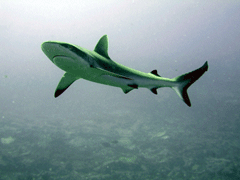
The shallow, remote coral reef systems of the Phoenix Islands provide an ideal shark nursery ground. (Courtesy of the New England Aquarium)
CURWOOD: The President of Kiribati, Anote Tong, was visiting the aquarium that day. The leader of 100,000 citizens living on 300 square miles of land, President Tong also administers more than a million square miles of ocean. As we started talking with Greg Stone, President Tong recalled life as a child in the islands.
TONG: We used to run after the fish, sometimes we’d get stung by many things, as small kids do, we’d get coral in our feet, but I think what is really brought home here is our ability to coexist with the marine ecology. And over the years of diving that I’ve been doing in the last 20 years I have seen changes, and so seeing what was the position in the Phoenix Islands, it was so necessary that we look after this. It has been bestowed to us, an endowment given by God – we didn’t get much else, so we thought it was necessary that we look after this.
CURWOOD: So Doctor Stone, go back to the moment that you first laid eyes on the Kirabati and the Phoenix Islands. What was that like?
STONE: We came over the horizon in a boat out of Fiji and we came up on an island called Nikumaroro, which is my favorite of all the Phoenix Islands. It’s a beautiful, beautiful island.
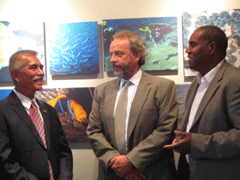
Anote Tong, Dr. Greg Stone, and Steve Curwood at the New England Aquarium.
CURWOOD: President Tong, let me turn to you. If fishing is the way people survive subsistence, and I imagine there’s some commercial interest there as well – if you make this whole area a conservation reserve, what happens to incomes locally?
TONG: I think what has to be understood is the Phoenix Islands are well away from the major population centers, so there is not that significant impact on the earning capacity of our local fishermen.
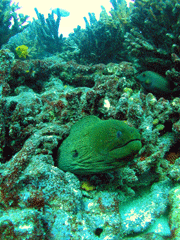
A green moray eel emerges from reef in Phoenix Islands. (Courtesy of the New England Aquarium)
CURWOOD: Obviously with some of the “big fish” there, it will upset people who have been using the area, I imagine South Korea has been fairly active there, perhaps Japan as well?
TONG: Yeah, you’re quite correct. The Koreans, the Japanese are not very happy – but I think this is where the question of compensation for that loss will be discussed.
CURWOOD: Greg Stone, from your side, you’ve been working with donors here in the U.S. to make it possible. How will this work, in your view?
STONE: The way it works is Kiribati allows foreign countries to come in and fish, and foreign countries pay Kiribati a licensing fee for that access. And we are analyzing exactly what those fees are for the area, the Phoenix Islands protected area, and then establishing an endowment that will pay Kiribati the lost revenues. So the fish stay in the ocean, Kiribati still gets its money, and everything works out.
CURWOOD: What about enforcement? Some of these fish, especially the big fish, are worth a lot of money. There may be rules that don’t permit the taking of them, but people may not respect those rules.

Two green sea turtles mating. The new Phoenix Islands Protected Area will provide an important habitat reserve green sea turtles, whose populations in the Pacific are in dramatic decline. (Courtesy of the New England Aquarium)
CURWOOD: President Tong, I want to talk to you about the changing oceans and climate change. A combination of the more acidified and toxified ocean and changing climate patterns really are killing off some of these coral reefs around the planet, and they’re also a threat to your nation. As projected sea level rises, so shrinks Kiribati.
TONG: From our own point of view, as people living in low-lying island countries, we’ve come to experience new phenomena. There are things that are happening now that did not happen in the past. There are villages which have been there over a century, and they’ve had to relocate. This poses unimaginable consequences for us, and we’ve raised that even at the United Nations General Assembly, and unfortunately have not had much interest, until recently. The ability of the islands to support plant and animal life will be significantly reduced, until eventually perhaps to the point when they will be totally uninhabitable. So the question arises, what do we do? Well obviously we cannot swim for the rest of the millennium, so we have to relocate, unfortunately we have to look at that option, undesirable as it may seem. And perhaps the sacrifice that we are making in terms of giving up part of our marine area, perhaps some countries will also make the sacrifice to give us some of their land area where we can survive as a community, as a nation, as a people. And we are hoping that the international community will be able to respond to this, one of the most serious moral challenges facing humanity at this point in time.
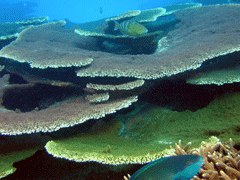
Table corals that take decades to form and are easily destroyed by commercial fishing activity. (Courtesy of the New England Aquarium)
[MUSIC: Kiribati: All music is taken from the film Paradise Found: The Phoenix Islands produced by The New England Aquarium (2005)]
CURWOOD: A familiar church song on Kiribati speaks to the courage it takes to journey out on the vast ocean where there are only little specks of land. Now, with sea levels rising, the people of Kiribati must prepare for a journey from which they cannot hope to return to their own land. But they can hope that their marine paradise will be protected forever.
[MUSIC: Kiribati: All music is taken from the film Paradise Found: The Phoenix Islands produced by The New England Aquarium (2005)]
To see pictures and film from the Phoenix Islands, go to our website, loe.org. Ashley Ahearn produced our segment on Kiribati.
[MUSIC: Kiribati: All music is taken from the film Paradise Found: The Phoenix Islands produced by The New England Aquarium (2005)]
CURWOOD: Coming up, the ecovillage that’s remaking the dry grasslands of Colombia. Keep your ear to the ground. It’s Living on Earth.
ANNOUNCER: Support for the Environmental Health Desk at Living on Earth comes from the Cedar Tree Foundation. Support also comes from the Richard and Rhoda Goldman fund for coverage of population and the environment. And from Gilman Ordway for coverage of conservation and environmental change. This is Living on Earth on PRI, Public Radio International.
Related links:
- Phoenix Islands Protected Area
- New England Aquarium
- Watch a movie about the Phoenix Islands
Last Bat Home
[MUSIC: Jimmy Herring: “New Moon” from Lifeboat (Abstract Logix Records 2008)]
CURWOOD: It's Living on Earth, I'm Steve Curwood.
KLINKENBORG: It’s 6:00am, a dark gray morning in late summer, the dim light a reminder that it’s two months on the downhill side of the season.
CURWOOD: Commentator Verlyn Klinkenborg.
KLINKENBORG: Ethel the Border Terrier and I are behind the house, investigating a woodchuck’s scent. There is a dark smudge in the mist above us, and then another. The bats are returning to their bat house – a thin, slatted box high up under the eaves. Each bat comes in over the roof, makes a dive for the ground and then swoops upward toward the narrow entrance of the bat-house. Some slip inside on the first try, some fall back and try again. After a few minutes, the air is still, the last bat home. Ethel and I turn toward breakfast.
I have seen the bats come out at evening again and again. It is one of the joys of living here, watching them drop one by one into the night. But I’ve seen them coming home only a few times. The bats of evening are the last flutter in a world that is growing still. The bats of morning have already been engulfed by birdsong, rooster-crow, the stirring of nearly every creature on this place. Their flight is less erratic just before roosting, no longer distracted by an insect in the air. It’s as though each bat brings a scrap of night’s darkness home with it, leaving the sky pale and brightening. It’s as though night itself were being stored in the bat-house till dusk.
When the last bat had vanished, I felt almost absurdly alone, strangely vacant in that thin slice of morning. It reminded me of a feeling from a long time ago – that moment, after staying up all night, when you can feel the world gathering pace and energy just as you’re beginning to fade, the city stirring, streets coming to life, a crescendo that grows and grows. You can almost pinpoint the moment when the city reaches full throttle. You glimpse, from outside, barely awake, what a powerful movement morning really is. There is no coaxing about it. It marches you right into the day, right through life.
Watching those dawn bats, I imagined them punching out of their night’s work as they settled, and I felt as if I’d somehow clocked into their schedule. Really, the best use of a dark gray morning with mist in the air is to go back to bed, only a few feet – and a couple of walls – away from where the bats are sleeping.
CURWOOD: Verlyn Klinkenborg writes editorials for the New York Times and lives on a farm in New York State.
[MUSIC: Gorillaz/Various Artists “Hong Kong” from Help: A Day In The Life (War Child Records 2005)]
A Village to Reinvent the World
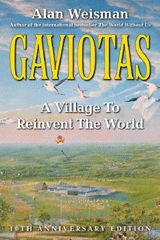
CURWOOD: Back in the 1970s, a group of South American scientists and engineers began work on a sustainable community in Colombia’s arid war-torn eastern plains – grasslands known as “Los Llanos.”
They named their ecovillage Gaviotas, and hoped it might serve as a model for sustainable development in the tropics. The founders experimented with agriculture and developed a host of affordable technologies that could be exported to other tropical communities.
In 1994, science journalist Alan Weisman produced a documentary on the project that ran on National Public Radio programs, including this one. In 1998 he wrote the book, “Gaviotas, a Village to Reinvent the World.”
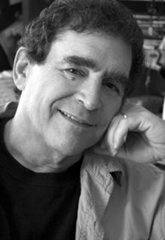
Author Alan Weisman (Courtesy of Chelsea Green)
WEISMAN: By the moonlight I can see it – a forest rising up from this formerly empty plain. Twelve years ago researchers discovered that pines from Honduras thrive in these thin soils. Since then, Gaviotas has planted more than a million. Instead of cutting them for timber, they’re selling the renewable sap for making paint and turpentine. They don’t earn as much money this way, but Gonzalo reminds me, that’s not the point.
[GONZALO SPEAKING IN SPANISH]
TRANSLATOR: We believe austerity is a better path to happiness and to man’s comfort. In Colombia’s oil camps, what have they gotten? Prostitution and alcoholism, because salaries are too high. Then the oil is gone. What’s left is misery.
[GONZALO SPEAKING IN SPANISH]
TRANSLATOR: Meanwhile we plant trees so the atmosphere won’t disappear.
[GONZALO SPEAKING IN SPANISH]
WEISMAN: Although ecologists originally questioned bringing a Central American species into Colombia’s Llanos, something amazing has happened.
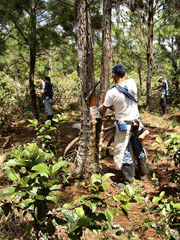
Caribbean Pine trees are tapped for resin. (Courtesy of Hollister Knowlton)
[CRICKET SOUNDS]
WEISMAN: In the moist understory of the Gaviotas Forest, dormant seeds of native trees probably not seen in Los Llanos in millennia are sprouting. Biologists have now counted at least forty species, which are sheltered by Caribbean Pines. Over the coming decades, Gaviotas will let these new native trees choke out the pines and return the Llanos to what many believe was their primeval state, an extension of the Amazon. Already the population of deer and anteaters is growing.
[CRICKET SOUNDS]
CURWOOD: So more than a decade ago people were hoping that one day, native species would be able to outcompete those Honduran pines they had planted. I know it’s only been a little more than ten years, but how does that forest look today?
WEISMAN: I was totally amazed. You stand right next to it and you really have to squint hard to realize that there are rows of pines between these really tall jacarondas and ficus and monkey pods and laurels and curary, and all these other beautiful trees that are growing there. Well, it turns out that the pine trees, growing among these natural species, are still producing plenty of resin. They’re growing really tall and really well themselves, so Gaviotas believes that this is a great example that polyculture is a much better way to go than monoculture. It’s ultimately healthier, even for the crop that you’re growing.
CURWOOD: I understand that the Gaviotans have introduced another non-native species of tree, the African Palm. Can you tell me about that?
WEISMAN: The Gaviotans are trying to do something that in other parts of the world is controversial – grow a non-native species, African Palm, which has a fruit that produces a lot of oil, and to turn it into biodiesel. The reason it’s controversial elsewhere is that native forests are being scraped away to produce palm oil, or farm crops are being replaced by energy crops. What Gaviotas is trying to do is the same thing that they have done with their pine resin plantation – is plant trees where nothing else is particularly growing anyhow. If they can, they’re going to produce enough biodiesel to fuel their own vehicles. There’s also a project proposed that the Colombian government is very interested in, to plant enough palm oil trees that would make the entire country of Colombia self-sufficient in biodiesel production. If this works, Gaviotas believes that treeless savannas all over the world could be the place to grow energy crops sustainably.
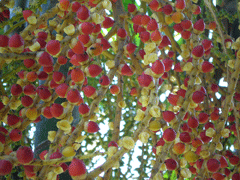
Fruit from oil palm trees can be converted to biodiesel. (Photo: Tansra Kaur)
CURWOOD: Now, one of the most fascinating aspects of the story is, in fact, all these inventions or adaptations of inventions really. In a way there’s just a whole series of, what I would call appropriate technologies for a less developed world. In fact, let’s listen to another piece of your original documentary – a point at which a guide in Gaviotas is showing you some of the various technologies that they have developed.
[CRICKETS]
WEISMAN: For years, Gaviotas has been a nonprofit foundation, a model for the United Nations development program. But to finance themselves, the Gaviotans must also market their technology. That isn’t so easy, Gonzalo says, since Gaviotas refuses to patent their inventions, preferring to share them.
[SOUND OF MACHINERY]
WEISMAN: The factory at Gaviotas employs many of the hundred and thirty Gaviotas residents, as well as people from surrounding communities. Here they produce the innovative devices that Gaviotas uses and sells, such as the windmills I saw on the way here.
[GONZALO SPEAKING IN SPANISH]
TRANSLATOR: We study 56 different windmills from all over the world until we got to this version.
WEISMAN: Its design has since been copied from Central America to Chile.
[GONZALO SPEAKING IN SPANISH]
WEISMAN: In one corner Gonzalo shows me stacks of solar panels that can heat water with diffuse sun light in rainy climates. Then he leads me across the factory floor to a machine resembling a stationary bicycle which uses pedal power to strip stalks of Cassava.
[GONZALO SPEAKING IN SPANISH AND MACHINE SOUNDS]
WEISMAN: Gonzalo and factory foreman Juan Navoa next take me outside to what they call Gaviotas’ most significant achievement. All I see is a yellow pump handle attached to a covered well.
[GONZALO SPEAKING IN SPANISH AND WATER FLOWING]
TRANSLATOR: This double action pump taps water six times deeper than normal models. Instead of raising and lowering the heavy piston inside a pipe, this one leaves the piston stationary and lifts the pipe made of plastic tubing.
[SOUND OF PUMPING AND WATER FLOWING]
WEISMAN: I try it.
[MORE PUMPING AND WATER FLOWING]
WEISMAN: It’s so light any child could do it. This simple, inexpensive pump has revolutionized rural life across Colombia for people who used to haul their water in buckets from muddy tropical rivers. But Gonzalo has something even more imaginative to show me.
[WOMEN AND CHILDREN SINGING IN SPANISH]
WEISMAN: When we arrive at the open air Gaviotas preschool children are on the playground.
[MORE SINGING, SQUEAKING OF SEESAW]
WEISMAN: Their seesaw is actually a pump in disguise. As they rise and descend water gushes from a vertical pipe into an open cement tank.
[SOUND OF FLOWING WATER AND SQUEAKING OF SEESAW]
WEISMAN: Over the years, Gaviotas technicians have installed these in thousands of schoolyards, using kid power to provide villages with clean water.
[TEACHER AND PRESCHOOLERS “BUENOS DIAS”]
CURWOOD: Tell me about the water in this region of Gaviotas.
WEISMAN: Much of the water in the area, when you get down to where those pumps are going, is actually artesian water. It’s coming down from the Andes, it’s seeping under this vast alluvial sandy field. It’s quite filtered, and they realized that there was money to be made if they bottled their incredibly pure, sweet water and sold it in the cities, which is what they are doing.
CURWOOD: So tell me a bit about their water bottling business and some of the engineering that they have in that.
WEISMAN: As always, the Gaviotans are never satisfied with the conventional way of doing things. And they realized that one of the problems was when you ship water, usually in cylindrical plastic bottles, and it takes up a lot of space. Could they stack ‘em even tighter? So somebody was looking one day at a kid playing with Lego blocks and realized: wow, if we put some indentation on one side of the bottle and put some bumps on the other side they could all fit together and they could stack much more tightly. That turned out to be a boon to stores to put these things on shelves and kids were saving the bottles – they’re now called “Legos de los pobres”, poor kids’ Legos, and then Gaviotas realized: well, you know we could also recycle these things by filling them with sand and using them as building blocks.
CURWOOD: You know that’s great Alan, but what concern is there about depleting their ground water if they, well, sell off too much of it.
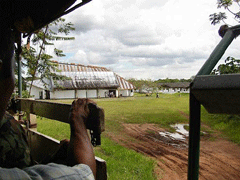
The Gaviotas community center where Gaviotans gather for meals. (Courtesy of Hollister Knowlton)
CURWOOD: Now the hope for Gaviotas was always to develop technologies that are appropriate to the tropics and serve as the model for other communities around the world. So how big of an impact has Gaviotas had on the region, and, for that matter, what kind of effect has it had around the world? Where else are people adopting the ideas out of Gaviotas?
WEISMAN: Gaviotas windmills and pumps can be found from Chile to Mexico. Gaviotas did a very good job of outreach in Colombia. There are many rural areas, in fact I can’t think of many I’ve ever traveled into that I didn’t see a Gaviotas implement or two. I was once in a Payas Indian village in southern Colombia where the installation of Gaviotas pumps immediately cured cholera. There are people in various parts of Colombia that are very grateful to Gaviotas.
CURWOOD: Alan Weisman’s book “Gaviotas: A Village to Reinvent the World” was just published in a tenth anniversary edition with an update. Alan Weisman, thanks so much for taking this time.
WEISMAN: It’s been a pleasure.
CURWOOD: And you can find a complete version of Alan Weisman's original documentary about Gaviotas on our website, loe.org.
[MUSIC: Jerry Garcia & David Grissman “Grateful Dawg” from The Grateful Dawg Soundtrack (Acoustic Disc 2001)]
Related links:
- To hear the original Gaviotas story, click here
- Click here for more information on Gaviotas
-
Seedy Art

CURWOOD: It’s the season of mists and mellow fruitfulness – and all of that bounty is on display at state fairs across the country – from jams and pies and cider to mammoth pumpkins, and prizewinning cabbages. And at the Minnesota harvest celebration in St Paul this year, Living on Earth’s Bobby Bascomb encountered an unusual display of art. She sends this audio postcard.
[MUSIC: Jerry Garcia & David Grissman “Grateful Dawg” from The Grateful Dawg Soundtrack (Acoustic Disc 2001)]
RUSSELL: My name is Beth Russell. I am from Western Minnesota. All of the artwork that you see on the wall is done with seeds from Minnesota farm crops. It has to be grown here. Therefore, white rice doesn’t work.
[MUSIC: Jerry Garcia & David Grissman “Grateful Dawg” from The Grateful Dawg Soundtrack (Acoustic Disc 2001)]
RUSSELL: So we use wheat and barley, and oats, corn, different varieties of corn, we might have some that looks more yellow, some that’s more red. Some of our lentils are green, some are orange. So there’s all kinds of colors in the scene. We have beans – kidney beans, lima beans, soy beans.
[MUSIC: Jerry Garcia & David Grissman “Grateful Dawg” from The Grateful Dawg Soundtrack (Acoustic Disc 2001)]
RUSSELL: The “founding mother” of crop art from Minnesota – I’m giving her that title – she’s called the Seed Queen. She has done Johnny Carson, Eleanor Roosevelt, and if you look at Eleanor Roosevelt in the seed art that Lillian Colton did, Eleanor’s teeth are beans, they’re great northern beans, which is just phenomenal to me.
[MUSIC: Jerry Garcia & David Grissman “Grateful Dawg” from The Grateful Dawg Soundtrack (Acoustic Disc 2001)]
RUSSELL: A typical seed art piece will have somewhere between eight to ten to twelve different kinds of seeds. We ask each one of our artists to come in with what we call a seed chart that tells us the name of the seed and shows us what it is. It’s a very important part of the display.
[MUSIC: Jerry Garcia & David Grissman “Grateful Dawg” from The Grateful Dawg Soundtrack (Acoustic Disc 2001)]
RUSSELL: One of our categories is wearable art. So I have corn on a chain, dangling from my ears. It’s a little zany, a bit of funkiness. A young man last year called me corn ears – it was very appropriate. It’s rather distinctive, actually, I get a lot of comments on it. I think it’s croppy. I think it looks croppy … [LAUGHING] … to go with farm crops.

Dolly Parton, made from seeds and cornhusks, on display at the Minnesota State Fair. (Moncrief Speaks)
CURWOOD: Living on Earth’s Bobby Bascomb sent us that audio postcard from the Minnesota State Fair.
[MUSIC: Jerry Garcia & David Grissman “Grateful Dawg” from The Grateful Dawg Soundtrack (Acoustic Disc 2001)]
Related link:
Click here for more information on seed art
CURWOOD: On the next Living on Earth – It’s no fish tale: the brook trout population may be declining dramatically in much of North America, from Labrador to Georgia.
But the freshwater fish are thriving in the streams of Maine.
MYRICK: A lot of times this one is almost dry, but you’ll find a hole that’s got six inches of water, and you’ll find the trout.
CURWOOD: Buckets full of brook trout - next time on Living on Earth.
CURWOOD: Living on Earth is produced by the World Media Foundation. Our crew includes Ashley Ahearn, Bobby Bascomb, Eileen Bolinsky, Bruce Gellerman, Ingrid Lobet, Helen Palmer, Mitra Taj and Jeff Young, with help from Sarah Calkins and Marilyn Govoni. Our interns are Sandra Larson and Jessie Martin. Jeff Turton is our technical director. Alison Lirish Dean composed our themes. You can find us at loe dot org. I’m Steve Curwood. Thanks for listening.
ANNOUNCER: Funding for Living on Earth comes from the National Science Foundation, supporting coverage of emerging science, and Stonyfield Farm: organic yogurt and smoothies. Stonyfield pays its farmers not to use artificial growth hormones on their cows. Details at stonyfield.com. Support also comes from you our listeners, the Ford Foundation, the Town Creek Foundation, and the Oak Foundation supporting coverage of climate change and marine issues; The Rockefeller Foundation and its Campaign for American Workers. More at rock found dot org. and Pax World Mutual Funds: socially and environmentally sustainable investing. Pax World: for tomorrow. On the web at paxworld.com.
Living on Earth wants to hear from you!
Living on Earth
62 Calef Highway, Suite 212
Lee, NH 03861
Telephone: 617-287-4121
E-mail: comments@loe.org
Newsletter [Click here]
Donate to Living on Earth!
Living on Earth is an independent media program and relies entirely on contributions from listeners and institutions supporting public service. Please donate now to preserve an independent environmental voice.
NewsletterLiving on Earth offers a weekly delivery of the show's rundown to your mailbox. Sign up for our newsletter today!
 Sailors For The Sea: Be the change you want to sea.
Sailors For The Sea: Be the change you want to sea.
 Creating positive outcomes for future generations.
Creating positive outcomes for future generations.
 Innovating to make the world a better, more sustainable place to live. Listen to the race to 9 billion
Innovating to make the world a better, more sustainable place to live. Listen to the race to 9 billion
 The Grantham Foundation for the Protection of the Environment: Committed to protecting and improving the health of the global environment.
The Grantham Foundation for the Protection of the Environment: Committed to protecting and improving the health of the global environment.
 Contribute to Living on Earth and receive, as our gift to you, an archival print of one of Mark Seth Lender's extraordinary wildlife photographs. Follow the link to see Mark's current collection of photographs.
Contribute to Living on Earth and receive, as our gift to you, an archival print of one of Mark Seth Lender's extraordinary wildlife photographs. Follow the link to see Mark's current collection of photographs.
 Buy a signed copy of Mark Seth Lender's book Smeagull the Seagull & support Living on Earth
Buy a signed copy of Mark Seth Lender's book Smeagull the Seagull & support Living on Earth

